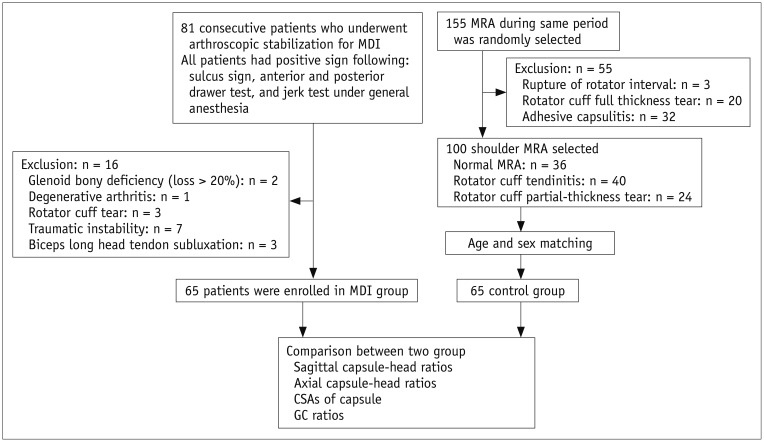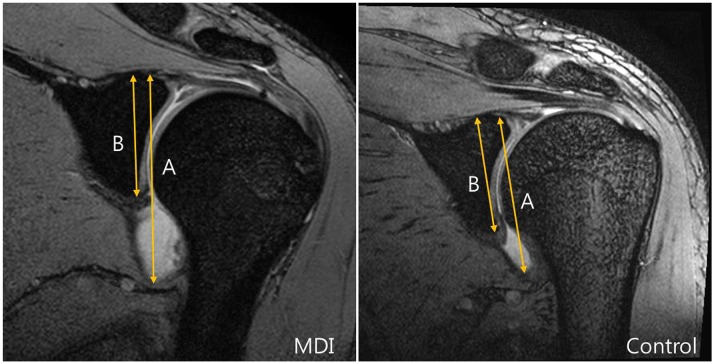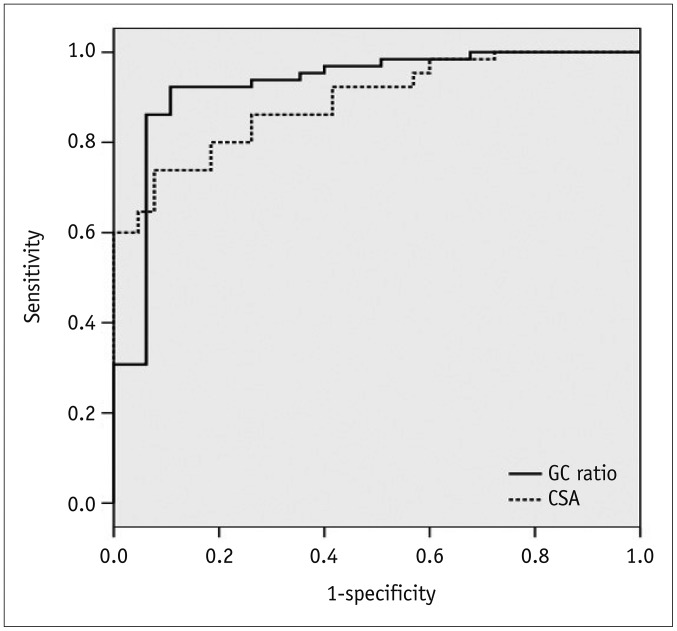Korean J Radiol.
2019 Jun;20(6):931-938. 10.3348/kjr.2018.0541.
Evaluation of Inferior Capsular Laxity in Patients with Atraumatic Multidirectional Shoulder Instability with Magnetic Resonance Arthrography
- Affiliations
-
- 1Goodsam Orthopaedic Clinic, Cheongju, Korea.
- 2Department of Orthopaedic Surgery, Chungbuk National University Hospital, Cheongju, Korea. hoseung1@gmail.com
- KMID: 2447071
- DOI: http://doi.org/10.3348/kjr.2018.0541
Abstract
OBJECTIVE
To compare inferior capsular redundancy by using magnetic resonance arthrography (MRA) images in patients with multidirectional instability (MDI) of the shoulder and control subjects without instability and thereby develop a screening method to identify the presence of shoulder MDI.
MATERIALS AND METHODS
The MRA images of patients with MDI of the shoulder (n = 65, 57 men, 8 women; mean age, 24.5 years; age range, 18-42 years) treated over an eight-year period were retrospectively reviewed; a control group (n = 65, 57 men, 8 women; mean age, 27.4 years; age range, 18-45 years) without instability was also selected. The inferior capsular redundancy was measured using a new method we named the glenocapsular (GC) ratio method. MRA images of both groups were randomly mixed together, and two orthopedic surgeon reviewers measured the cross-sectional areas (CSAs) and sagittal capsule-head ratios on oblique sagittal images, as well as the axial capsule-head ratios on axial images and GC ratios on oblique coronal images.
RESULTS
The CSAs and GC ratios were significantly higher in patients than in controls (both, p < 0.001); however, the sagittal capsule-head ratios and axial capsule-head ratios were not significantly different (p = 0.317, p = 0.053, respectively). In addition, GC ratios determined the presence of MDI more sensitively and specifically than did CSAs. A GC ratio of > 1.42 was found to be most suggestive of MDI of the shoulder, owing to its high sensitivity (92.3%) and specificity (89.2%).
CONCLUSION
GC ratio can be easily measured and used to accurately screen for MDI of the shoulder.
Keyword
MeSH Terms
Figure
Reference
-
1. Neer CS 2nd, Foster CR. Inferior capsular shift for involuntary inferior and multidirectional instability of the shoulder. A preliminary report. J Bone Joint Surg Am. 1980; 62:897–908. PMID: 7430177.
Article2. Gerber C, Nyffeler RW. Classification of glenohumeral joint instability. Clin Orthop Relat Res. 2002; (400):65–76.
Article3. Choi CH, Ogilvie-Harris DJ. Inferior capsular shift operation for multidirectional instability of the shoulder in players of contact sports. Br J Sports Med. 2002; 36:290–294. PMID: 12145120.
Article4. Misamore GW, Sallay PI, Didelot W. A longitudinal study of patients with multidirectional instability of the shoulder with seven- to ten-year follow-up. J Shoulder Elbow Surg. 2005; 14:466–470. PMID: 16194736.
Article5. Pollock RG, Owens JM, Flatow EL, Bigliani LU. Operative results of the inferior capsular shift procedure for multidirectional instability of the shoulder. J Bone Joint Surg Am. 2000; 82-A:919–928. PMID: 10901306.
Article6. McIntyre LF, Caspari RB, Savoie FH 3rd. The arthroscopic treatment of multidirectional shoulder instability: two-year results of a multiple suture technique. Arthroscopy. 1997; 13:418–425. PMID: 9276046.
Article7. Johnson SM, Robinson CM. Shoulder instability in patients with joint hyperlaxity. J Bone Joint Surg Am. 2010; 92:1545–1557. PMID: 20516333.
Article8. Levine WN, Prickett WD, Prymka M, Yamaguchi K. Treatment of the athlete with multidirectional shoulder instability. Orthop Clin North Am. 2001; 32:475–484. PMID: 11888142.
Article9. Barden JM, Balyk R, Raso VJ, Moreau M, Bagnall K. Atypical shoulder muscle activation in multidirectional instability. Clin Neurophysiol. 2005; 116:1846–1857. PMID: 15982928.
Article10. Hsu YC, Pan RY, Shih YY, Lee MS, Huang GS. Superior-capsular elongation and its significance in atraumatic posteroinferior multidirectional shoulder instability in magnetic resonance arthrography. Acta Radiol. 2010; 51:302–308. PMID: 20158433.
Article11. Lee HJ, Kim NR, Moon SG, Ko SM, Park JY. Multidirectional instability of the shoulder: rotator interval dimension and capsular laxity evaluation using MR arthrography. Skeletal Radiol. 2013; 42:231–238. PMID: 22639206.
Article12. Kim KC, Rhee KJ, Shin HD, Kim YM. Estimating the dimensions of the rotator interval with use of magnetic resonance arthrography. J Bone Joint Surg Am. 2007; 89:2450–2455. PMID: 17974888.
Article13. Lim CO, Park KJ, Cho BK, Kim YM, Chun KA. A new screening method for multidirectional shoulder instability on magnetic resonance arthrography: labro-capsular distance. Skeletal Radiol. 2016; 45:921–927. PMID: 26992912.
Article14. Dewing CB, McCormick F, Bell SJ, Solomon DJ, Stanley M, Rooney TB, et al. An analysis of capsular area in patients with anterior, posterior, and multidirectional shoulder instability. Am J Sports Med. 2008; 36:515–522. PMID: 18216272.
Article15. Helmig P, Søjbjerg JO, Kjaersgaard-Andersen P, Nielsen S, Ovesen J. Distal humeral migration as a component of multidirectional shoulder instability. An anatomical study in autopsy specimens. Clin Orthop Relat Res. 1990; (252):139–143. PMID: 2302878.16. Kim SH, Kim HK, Sun JI, Park JS, Oh I. Arthroscopic capsulolabroplasty for posteroinferior multidirectional instability of the shoulder. Am J Sports Med. 2004; 32:594–607. PMID: 15090373.
Article17. Shafer BL, Mihata T, McGarry MH, Tibone JE, Lee TQ. Effects of capsular plication and rotator interval closure in simulated multidirectional shoulder instability. J Bone Joint Surg Am. 2008; 90:136–144. PMID: 18171968.
Article18. Lubowitz J, Bartolozzi A, Rubinstein D, Ciccotti M, Schweitzer M, Nazarian L, et al. How much does inferior capsular shift reduce shoulder volume? Clin Orthop Relat Res. 1996; (328):86–90.
Article
- Full Text Links
- Actions
-
Cited
- CITED
-
- Close
- Share
- Similar articles
-
- Magnetic Resonance Arthrography in the evaluation of Anterior Glenohumeral Instability
- Neer's Inferior Capsular shift for Involuntary Inferior and Multidirectional Instability of the Shoulder
- Medial Anterior-inferior Capsular Shift in Multidirectional Shoulder Instability
- Three-dimensional Capsular Volume Measurements in Multidirectional Shoulder Instability
- CT Arthrographic Finding in Shoulder Instability







